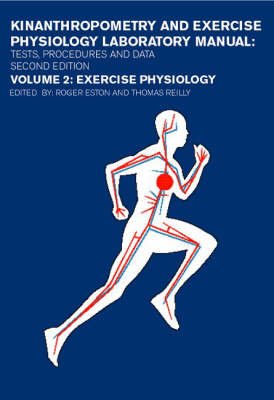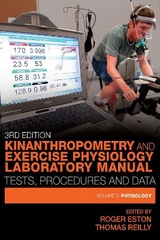
Kinanthropometry and Exercise Physiology Laboratory Manual: Tests, Procedures and Data
Volume Two: Exercise Physiology
Seiten
2001
|
2nd New edition
Routledge (Verlag)
978-0-415-25188-4 (ISBN)
Routledge (Verlag)
978-0-415-25188-4 (ISBN)
- Titel erscheint in neuer Auflage
- Artikel merken
Zu diesem Artikel existiert eine Nachauflage
This new, fully revised edition provides help and guidance in the planning and conduct of practical work. There is a comprehensive theoretical background for each topic covered so that there is no need for additional reading.
This is the second edition of the highly successful Kinanthropometry and Exercise Physiology Laboratory Manual. Developed as a key resource for lecturers and students of kinanthropometry, sports science, human movement and exercise physiology, this edition is thoroughly revise and completely up-to-date. Now divided into two volumes - Anthropometry and Exercise Physiology - this manual provides:
help in planning and conduct of practical sessions
comprehensive theoretical background on each topic, and up-to-date information so that there is no need for additional reading
seven entirely new chapters providing a balance between kinanthropometry and physiology
eleven self-standing chapters in each volume enabling the reader to pick out topics of interest in any order
a wide range of supporting diagrams, photographs and tables.
Volume One: Anthropometry covers body composition, proportion, size, growth and somatotype and their relationship with health performance; methods for evaluating posture and range of motion; assessment of physical activity and energy balance with particular reference to the assessment of performance in children; the relationship between anthropometry and body image; statistics and scaling methods in kinanthropometry and exercise physiology. Volume Two: Exercise Physiology covers the assessment of muscle function including aspects of neuromuscular control and electromyography; the oxygen transport system and exercise including haemotology, lung and cardiovascular function; assessment of metabolic rate, energy and efficiency including thermoregualtion; and assessment of maximal and sub-maximal energy expenditure and control, including the use of heart rate, blood lactate and perceived exertion. An entire one-stop resource, these volumes present laboratory procedures next to real-life practical examples, each supported with appropriate data. In addition, each chapter is supplemented by a complete review of contemporary literature, as well as theoretical overviews, offering an excellent basic introduction to each topic.
This is the second edition of the highly successful Kinanthropometry and Exercise Physiology Laboratory Manual. Developed as a key resource for lecturers and students of kinanthropometry, sports science, human movement and exercise physiology, this edition is thoroughly revise and completely up-to-date. Now divided into two volumes - Anthropometry and Exercise Physiology - this manual provides:
help in planning and conduct of practical sessions
comprehensive theoretical background on each topic, and up-to-date information so that there is no need for additional reading
seven entirely new chapters providing a balance between kinanthropometry and physiology
eleven self-standing chapters in each volume enabling the reader to pick out topics of interest in any order
a wide range of supporting diagrams, photographs and tables.
Volume One: Anthropometry covers body composition, proportion, size, growth and somatotype and their relationship with health performance; methods for evaluating posture and range of motion; assessment of physical activity and energy balance with particular reference to the assessment of performance in children; the relationship between anthropometry and body image; statistics and scaling methods in kinanthropometry and exercise physiology. Volume Two: Exercise Physiology covers the assessment of muscle function including aspects of neuromuscular control and electromyography; the oxygen transport system and exercise including haemotology, lung and cardiovascular function; assessment of metabolic rate, energy and efficiency including thermoregualtion; and assessment of maximal and sub-maximal energy expenditure and control, including the use of heart rate, blood lactate and perceived exertion. An entire one-stop resource, these volumes present laboratory procedures next to real-life practical examples, each supported with appropriate data. In addition, each chapter is supplemented by a complete review of contemporary literature, as well as theoretical overviews, offering an excellent basic introduction to each topic.
bPart One: Neuromuscular Aspects of Movement 1. Skeletal Muscle Function 2. Assessment of Neuromuscular Performance Using Electromyography Two: Oxygen Transport System and Exercise 3. Lung Function 4. Haematology 5. Cardiovascular Function 6. Basal Metabolic Rate 7. Maximal Oxygen Uptake, Economy and Efficiency 8. Thermoregulation Part Four: Section Four: Assessment and Regulation of Energy Expenditure and Exercise Intensity 9. Control of Exercise Intensity Using Heart Rate, Perceived Exertion and Other Non-Invasive Procedures 10. Limitations to Submaximal Exercise Performance 11. Assessment of Maximal Intensity Exercise Appendix: Relationships Between Units of Energy, Work, Power and Speed
| Erscheint lt. Verlag | 26.7.2001 |
|---|---|
| Verlagsort | London |
| Sprache | englisch |
| Maße | 189 x 246 mm |
| Gewicht | 862 g |
| Themenwelt | Studium ► 1. Studienabschnitt (Vorklinik) ► Physiologie |
| ISBN-10 | 0-415-25188-5 / 0415251885 |
| ISBN-13 | 978-0-415-25188-4 / 9780415251884 |
| Zustand | Neuware |
| Haben Sie eine Frage zum Produkt? |
Mehr entdecken
aus dem Bereich
aus dem Bereich



